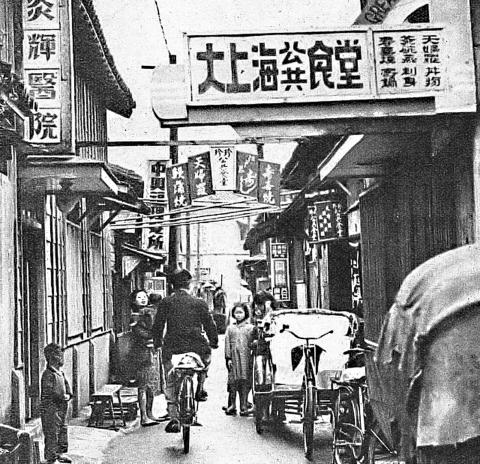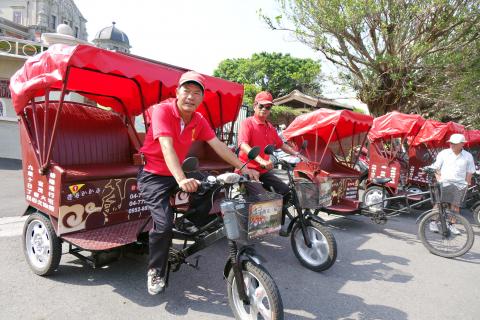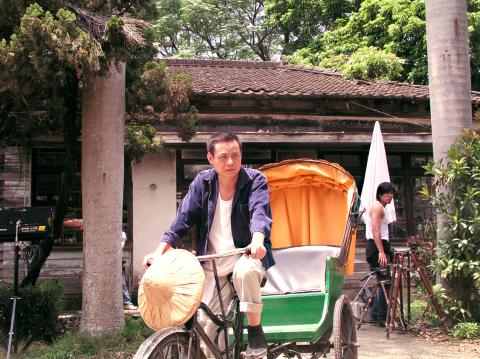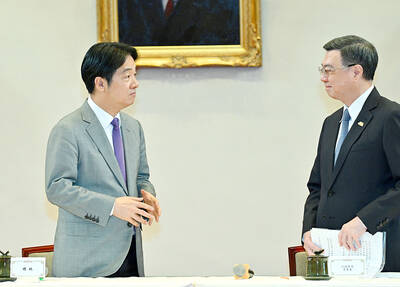June 19 to June 25
Chang Shoou-yuh (張守玉) recalls his father toiling long hours every day as a three-wheeled pedicab driver in Taipei shortly after their arrival in Taiwan following the Chinese Civil War.
“It was barely enough to support the family,” he says in Dogwood (茱萸花), an autobiography ghostwritten by Chien Ting-ting (蹇婷婷). “But everyone was poor back then … When I got sick, my father would take me in the pedicab to the hospital at Daqiaotou (大橋頭). It was a complicated feeling — I was enjoying my father’s love but I also felt sad that he had to work so hard. And although it wasn’t a shameful profession, there was some sort of pride that made me not want people to know that my father was a pedicab driver.”

Photo courtesy of Wikimedia Commons
The family’s fortunes took a turn for the worse when the government launched a plan in the early 1960s to eliminate pedicabs in Taipei by purchasing them and helping them transition to driving taxis instead. On June 25, 1968, Taipei completely banned the use of pedicabs.
“My father was almost 50 years old then, and since he was illiterate he couldn’t take the taxi driver exam,” Chang says. “We only received a small fee of NT$3,000 from the government. He basically lost his job.”
Chang started working to support the family and put himself through school, eventually earning a doctorate in environmental engineering from the University of Illinois — but that is another story.

Photo: Liu Hsiao-hsin, Taipei Times
PEDICAB MEMORIES
According to a Ministry of Education-produced lesson about the history of cycling in Taiwan, pedicabs first arrived in 1942 from Japan. After World War II, they were imported from Hong Kong and China. It was a popular means of public transportion, reaching a peak in 1960 with about 44,000 cabs operating around the country. About 14,000 of them were in Taipei.
“A driver once said, ‘You’ll be poor for the rest of your life if you drive a pedicab,’” writes Cheng Yi-ying (鄭懿瀛) for a Central News Agency feature. “But although they were poor, many people raised their families with the meager wages that they earned.”

Photo: Tsai Tsung-hsun, Taipei Times
There were two types of operation. Some had specific shifts and waited at designated spots; others cruised the streets looking for customers, who negotiated the price with the driver.
Formosa Vintage Museum (秋惠文庫) founder Lin Yu-fang (林于昉) recalls in an Apple Daily article that there would always be several pedicabs waiting outside his childhood home off Xinsheng S Road (新生南路) in the 1960s. A wealthy elementary school classmate had a private pedicab driver, and Lin recalls chasing it after school with a group of classmates, yelling “give us a ride too!”
He adds that back then, most pedicabs-for-hire had a number spray painted on the frame along with the words “Annihilate the communist bandits and save our compatriots (消滅共匪、解救同胞).” Private owners made sure their pedicabs were always clean and shiny, not unlike taxi drivers today.
TAXIS TAKE OVER
The government initially limited the number of taxis according to population — for example, in Taipei, one vehicle was allowed to operate per 5,000 residents in 1950. The number was changed to 2,000 in 1957 (along with an ordinance requiring all vehicles to install meters and a “taxi” sign on top). In 1959, the cap was lifted, resulting in a huge explosion of taxis, causing much chaos on the roads.
Of course, pedicab drivers were not happy and according to The History of Transportation in the Republic of China (中華民國交通史), there were several incidents where pedicab drivers gathered together to stop taxis from picking up customers.
However, the Taipei City Police Department, Department of Transportation and the Directorate General of Highways decided that pedicabs were outdated and started phasing them out by compensating pedicab drivers for their vehicles and providing automobile driving and repair classes for them until they obtained their drivers’ license. Unfortunately, some people fell through the cracks, such as Chang’s father.
According to A Study of Taxi Management in Taipei City (台北市計程車管理之研究), there were 7,450 taxis operating in Taipei at the end of 1968. The government’s plan worked, as that number had more than tripled by 1978 while pedicabs had completely disappeared. There were cabs of all colors back then, with many drivers favoring auspicious red. It wasn’t until 1991 that the government mandated that all of them be yellow.
Other cities followed Taipei’s lead, with Kaohsiung’s Cijin Island (旗津島) as the only place where pedicabs never went away — although today they are more of a tourist draw than transportation tool. According to the Cijin District Web site, 15 pedicabs are in operation today.
Taiwan in Time, a column about Taiwan’s history that is published every Sunday, spotlights important or interesting events around the nation that have anniversaries this week.

Under pressure, President William Lai (賴清德) has enacted his first cabinet reshuffle. Whether it will be enough to staunch the bleeding remains to be seen. Cabinet members in the Executive Yuan almost always end up as sacrificial lambs, especially those appointed early in a president’s term. When presidents are under pressure, the cabinet is reshuffled. This is not unique to any party or president; this is the custom. This is the case in many democracies, especially parliamentary ones. In Taiwan, constitutionally the president presides over the heads of the five branches of government, each of which is confusingly translated as “president”

Sept. 1 to Sept. 7 In 1899, Kozaburo Hirai became the first documented Japanese to wed a Taiwanese under colonial rule. The soldier was partly motivated by the government’s policy of assimilating the Taiwanese population through intermarriage. While his friends and family disapproved and even mocked him, the marriage endured. By 1930, when his story appeared in Tales of Virtuous Deeds in Taiwan, Hirai had settled in his wife’s rural Changhua hometown, farming the land and integrating into local society. Similarly, Aiko Fujii, who married into the prominent Wufeng Lin Family (霧峰林家) in 1927, quickly learned Hoklo (commonly known as Taiwanese) and

The Venice Film Festival kicked off with the world premiere of Paolo Sorrentino’s La Grazia Wednesday night on the Lido. The opening ceremony of the festival also saw Francis Ford Coppola presenting filmmaker Werner Herzog with a lifetime achievement prize. The 82nd edition of the glamorous international film festival is playing host to many Hollywood stars, including George Clooney, Julia Roberts and Dwayne Johnson, and famed auteurs, from Guillermo del Toro to Kathryn Bigelow, who all have films debuting over the next 10 days. The conflict in Gaza has also already been an everpresent topic both outside the festival’s walls, where

The low voter turnout for the referendum on Aug. 23 shows that many Taiwanese are apathetic about nuclear energy, but there are long-term energy stakes involved that the public needs to grasp Taiwan faces an energy trilemma: soaring AI-driven demand, pressure to cut carbon and reliance on fragile fuel imports. But the nuclear referendum on Aug. 23 showed how little this registered with voters, many of whom neither see the long game nor grasp the stakes. Volunteer referendum worker Vivian Chen (陳薇安) put it bluntly: “I’ve seen many people asking what they’re voting for when they arrive to vote. They cast their vote without even doing any research.” Imagine Taiwanese voters invited to a poker table. The bet looked simple — yes or no — yet most never showed. More than two-thirds of those